
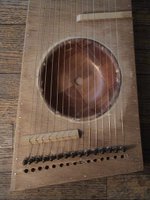


My Oblique Strategy for the Double Thumb Piano Zither is Abandon Normal Instruments


One day we shall be reunited, until then I will think of you fondly.
My Oblique Strategy for the Door-o-Phone was Simply a matter of work

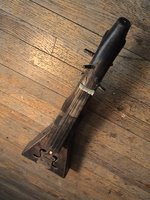
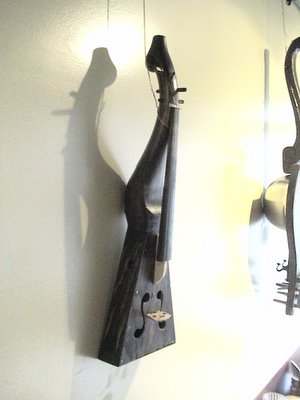
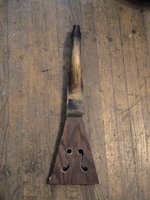 This is my first real attempt at trying to document the steps one would take when deciding to build a functional and aesthetically pleasing
This is my first real attempt at trying to document the steps one would take when deciding to build a functional and aesthetically pleasing experimental instrument. I did put a lot of work into the sound design of this particular instrument. There is a sound post placed just under the bridge, and a piece of wood glues on to the underside running length wise that is suppose to pick up more of the bass of the instrument. It also has a contact mic build directly into the belly of this strange beast. The neck was found somewhere close to
experimental instrument. I did put a lot of work into the sound design of this particular instrument. There is a sound post placed just under the bridge, and a piece of wood glues on to the underside running length wise that is suppose to pick up more of the bass of the instrument. It also has a contact mic build directly into the belly of this strange beast. The neck was found somewhere close to  Alex’s Left Handed Bass, but that’s a story for another day. The rest of the body I built myself. As you can tell it looks something like a triangle. That’s because things with too many curve make me feel uncomfortable. The output is on the left hand side of the instrument, a simple quarter inch output. I do wish I had of put a volume control somewhere.
Alex’s Left Handed Bass, but that’s a story for another day. The rest of the body I built myself. As you can tell it looks something like a triangle. That’s because things with too many curve make me feel uncomfortable. The output is on the left hand side of the instrument, a simple quarter inch output. I do wish I had of put a volume control somewhere. So plug it in and rock on, or something along those lines. Maybe you’re into Jazz?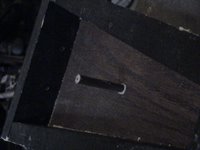
Unfortunately I never really got the chance to play, or rather in my case, make horrible screeching cat death like noises. This instrument along with almost all my others is currently hanging in a show I have in Parkdale. The place is called Mitzi’s Sister. It’s a great place to see live bands seven days a week for free. They also have a great permanent collection of art hanging in the music area done by yours truly. Just scroll down this increasing large page to find out which instruments are there.
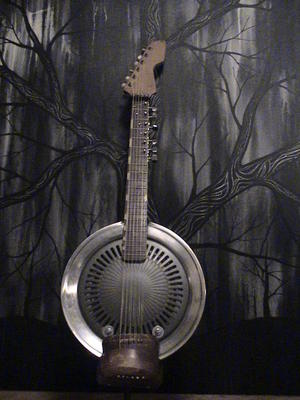



 I found this instrument in a pile of trash in my space room. It was something I built many years ago and forgotten about. When I found it had about ten useless strings on it. Five different speakers place at various points on the instrument that I wired all together in hopes of finding some interesting kind of pick up, that didn’t work at all. For the most part I would stay away from using a speaker as a microphone, but experiment, on the rare occasion it does work like with the Sunflower of Death. I also used a contact mic with the Sunflower. There were also three tin cans with racket balls mounted in them to be used with sticks. These sucked, they really, really sucked. So after I found this mess I was ready to just throw it out. It wasn’t until I was half way through striping it for screws, nuts and bolts that I realized the Metal Gopichand could be built back into its original idea. I often find that if I work on something too long I end up over doing the instrument, or any form of art for that matter. Sometimes simplicity is best.
I found this instrument in a pile of trash in my space room. It was something I built many years ago and forgotten about. When I found it had about ten useless strings on it. Five different speakers place at various points on the instrument that I wired all together in hopes of finding some interesting kind of pick up, that didn’t work at all. For the most part I would stay away from using a speaker as a microphone, but experiment, on the rare occasion it does work like with the Sunflower of Death. I also used a contact mic with the Sunflower. There were also three tin cans with racket balls mounted in them to be used with sticks. These sucked, they really, really sucked. So after I found this mess I was ready to just throw it out. It wasn’t until I was half way through striping it for screws, nuts and bolts that I realized the Metal Gopichand could be built back into its original idea. I often find that if I work on something too long I end up over doing the instrument, or any form of art for that matter. Sometimes simplicity is best. All you need is an old body from a salon hairdryer, a chicken cooking grill plate, and some parts from an old chair. OK maybe some tuning pegs and guitar strings thrown in for sound.
All you need is an old body from a salon hairdryer, a chicken cooking grill plate, and some parts from an old chair. OK maybe some tuning pegs and guitar strings thrown in for sound.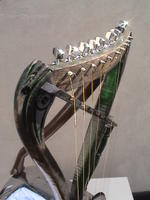 a moment. So when the idea of building a harp from a hairdryer came into my head I knew just where to go. I dumped out the shinny metal bits on the floor, where they still lay. The chair parts were lost a few months ago under our too small to be comfortable couch. The grill plates are scattered throughout our apartment, and the machine heads and strings are at Steve’s Music downtown. It’s that easy. I think I might put the fan blower back in just in case I need to do something with my hair.
a moment. So when the idea of building a harp from a hairdryer came into my head I knew just where to go. I dumped out the shinny metal bits on the floor, where they still lay. The chair parts were lost a few months ago under our too small to be comfortable couch. The grill plates are scattered throughout our apartment, and the machine heads and strings are at Steve’s Music downtown. It’s that easy. I think I might put the fan blower back in just in case I need to do something with my hair.
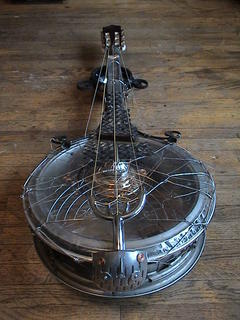
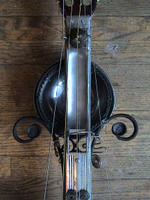 This is by far the ugliest of all the instruments I have built, and for some reason that makes me love it all the more. It was suppose to be a simple hand drum in the beginning. Sometimes these things have a life of there own, and there is absolutely nothing you can do about it.
This is by far the ugliest of all the instruments I have built, and for some reason that makes me love it all the more. It was suppose to be a simple hand drum in the beginning. Sometimes these things have a life of there own, and there is absolutely nothing you can do about it. So I guess it's kind of like a cross between a cello and a banjo made from a snare drum. It'’s not as scary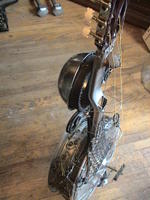
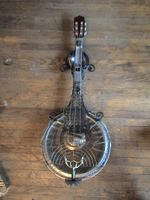 as it sounds. There are only two frets on the instrument, but they sit about three inches off the neck. There are three bowed strings, two drone strings, and one sympathetic string. I have no idea why that their, aside from the fact that I had one tuning peg without a string. That'’s good enough of a reason for me. The swirls are from one my metal dresses that was mostly destroyed in a fire. I'm glad this little bit found itself a new home.
as it sounds. There are only two frets on the instrument, but they sit about three inches off the neck. There are three bowed strings, two drone strings, and one sympathetic string. I have no idea why that their, aside from the fact that I had one tuning peg without a string. That'’s good enough of a reason for me. The swirls are from one my metal dresses that was mostly destroyed in a fire. I'm glad this little bit found itself a new home.
Even if that home is really freaking ugly.
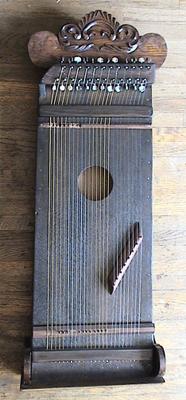
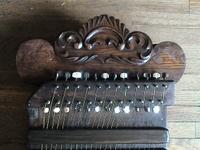 This instrument was built mostly from materials that I recovered from a job site that I was working on. The head stock which is to the right was originally part of a broken mirror frame that I found in the basement of Mitzi's Cafe. I cut it down to fit the width of the instrument, but made no attempt at changing the color of stain. Part of the joy in building these instruments out of garbage and what not, is the challenge of finding different things that work well together; with as few alterations as possible. Other parts of the mirror also went into building the Harp Bass, and Tony's Bass. The idea for building the 24 Stringed Grandfather was loosely based on the hammer dulcimer. What I did with the strings is quite different though. The first eight strings are set up the same as any of the MV series.The
This instrument was built mostly from materials that I recovered from a job site that I was working on. The head stock which is to the right was originally part of a broken mirror frame that I found in the basement of Mitzi's Cafe. I cut it down to fit the width of the instrument, but made no attempt at changing the color of stain. Part of the joy in building these instruments out of garbage and what not, is the challenge of finding different things that work well together; with as few alterations as possible. Other parts of the mirror also went into building the Harp Bass, and Tony's Bass. The idea for building the 24 Stringed Grandfather was loosely based on the hammer dulcimer. What I did with the strings is quite different though. The first eight strings are set up the same as any of the MV series.The next six strings which are all raised up slightly higher are set as individually tuned drone strings, or you could also use a slide. The last eight strings are set up to be played like the Larcksichord, which you can read more about further down the page. In an attempt to waste little of the salvaged materials I use the base was made from the remaining parts of the mirror frame. One of the main problems with this instrument is it's ability to be tuned. The first obvious problem is that half of the tuning pegs actually sit just below the strings, so it can be very difficult, almost to the point of annoying to get your stubby fingers in there. The second problem which is a bit more of a pain is the fact that the wood where the strings
next six strings which are all raised up slightly higher are set as individually tuned drone strings, or you could also use a slide. The last eight strings are set up to be played like the Larcksichord, which you can read more about further down the page. In an attempt to waste little of the salvaged materials I use the base was made from the remaining parts of the mirror frame. One of the main problems with this instrument is it's ability to be tuned. The first obvious problem is that half of the tuning pegs actually sit just below the strings, so it can be very difficult, almost to the point of annoying to get your stubby fingers in there. The second problem which is a bit more of a pain is the fact that the wood where the strings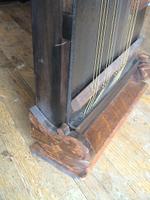 are fed into near the head stock sits about an inch and a half lower than the tuning pegs. This causes a lot of tension, and prevents easy movement between the two, therefore making it difficult to get proper tension on the strings. I will be working on this problem soon. How though, I'm not that sure.
are fed into near the head stock sits about an inch and a half lower than the tuning pegs. This causes a lot of tension, and prevents easy movement between the two, therefore making it difficult to get proper tension on the strings. I will be working on this problem soon. How though, I'm not that sure.

Metal Tambura, Metal Tambura. Over, and over again.
This instrument sounds great with a slide and a contact mic. Made from a serving plate I found at the Goodwill, an aluminum tube I cut in half, and various scavenged guitar parts, and my favorite, the salad bowl. Yes sir I love those salad bowls. Really, I love salad bowls for some bizarre reason. I based this instrument completely on the Tambura. The length of the neck was measured out from some schematics I found on the internet, along with the placement, and amount of strings. The bridge placement was measured back from the nut. I don't really know why there are two nuts up there, or if I really did base that on a real Tambura. I could be making all this stuff up. I'm not really all that sure that anybody will even read these things.

 I rebuilt this from the old Larksichord when I realized that my wood working skills had most definitely needed some work. I am much happier with this new version.
I rebuilt this from the old Larksichord when I realized that my wood working skills had most definitely needed some work. I am much happier with this new version. The top half of the instrument is designed to be played acoustically.
The top half of the instrument is designed to be played acoustically.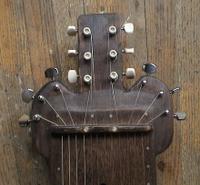

This is a collection of all my other stringed instruments to date. Plenty of the older ones are where the greatest suck factor comes in, and yet in some way I can’t help but feel nostalgic for the good old days when I had no idea what the heck I was doing.

This is a collection of all my other stringed instruments to date. Plenty of the older ones are where the greatest suck factor comes in, and yet in some way I can’t help but feel nostalgic for the good old days when I had no idea what the heck I was doing.